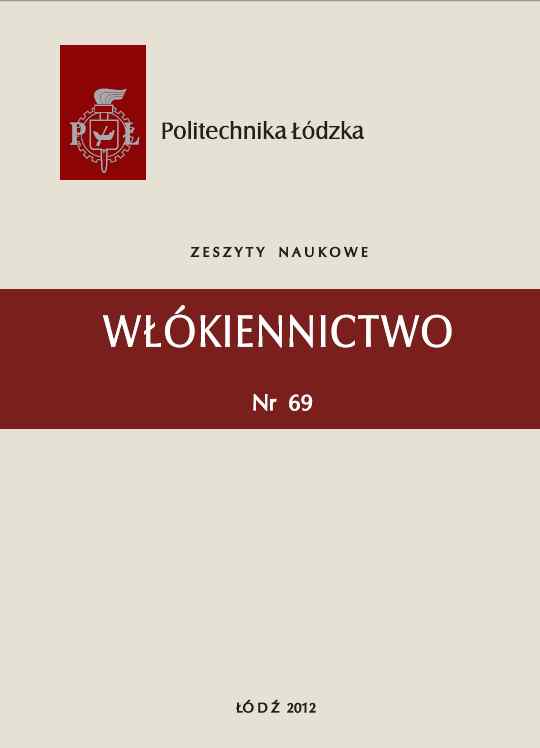Abstrakt
W niniejszym referacie jest opisana instrumentalna metoda oceny intensywności pillingu płaskich wyrobów włókienniczych. Obecnie w praktyce laboratoryjnej jest stosowana organoleptyczna, subiektywna metoda oceny zjawiska pillingu, zawarta m.in. w normach PN-EN ISO 12945-1/2:2002. Celem pracy było opracowanie i scharakteryzowanie w ujeciu metrologicznym nowej, instrumentalnej metody oceny pillingu opartej na komputerowym przetwarzaniu i analizie obrazu spillingowanej próbki. W pracy została przedstawiona budowa stanowiska pomiarowego oraz procedura pomiaru pillingu. Nastepnie został określony model jakosciowy metody, zostały zidentyfikowane i zbadane czynniki mogące mieć potencjalny wpływ na wyniki pomiaru. Zostały także określone metrologiczne cechy metody instrumentalnej, jak czułość, próg pobudliwości. Została także zbadana zależnosc korelacyjna z wynikami uzyskanymi metodą znormalizowaną.
Bibliografia
Żurek W.. Kopias K., Struktura płaskich wyrobów włókienniczych, Wyd. II, WNT, Warszawa 1983.
PN-EN ISO 12945-1:2002, Tekstylia. Wyznaczanie skłonności powierzchni płaskiego wyrobu do mechacenia i pillingu. Część 1: Skrzynkowa metoda badania pillingu.
Konda A. i inni, Evaluation of pilling by computer image analysis, J. Textile March. Soc. Japan, Vol. 36, No. 3, 1990, s. 96-107.
Ramgulam R., Amirbayat J., Porat I., The Objective Assessment of Fabric Pilling. Part. I: Methodology, Journal of Textile Institute No. 2, 1993, s. 221-226.
Amirbayat J., Alagha M., The Objective Assessment of Fabric Pilling. Part. I: Experimental Work, Journal of Textile Institute 85 No. 3, 1994, s. 397-401.
Hsi C., Bresee R., Annis P., Characterizing Fabric Pilling by Using Image-analysis Techniques. Part 2: Comparison with Visual Pill Ratings, Journal of Textile Institute 89, No. 1, 1998, s. 96-105.
Xu B., Instrumental Evaluation of Fabric Pilling, Journal of Textile Institute 88, No. 4, 1997, s. 488-500.
Jensen K., Carstensen J., Fuzz and Pills Evaluated on Knitted Textiles by Image Analysis, Textile Research Journal 72 (1) 2002, s. 34-38.
Behera B., Mohan T., Objective measurement of pilling by using image processing technique, Int. J. of Clothing Science and Technology Vol. 17, No. 5205.
Palmer S., Joud I., Wang X., Characterization and application of objective pilling classification to patterned fabrics, Journal of Textile Institute 96, No. 6, 2005, s. 423-430.
Palmer S., Wang X., Objective Classification of Fabric Pilling Based on the Two-Dimensional Discrete Wavelet Transform, Textile Research Journal 73 (8) 2003, s. 713-720.
Kim S., Kang T., Image Analysis of Standard Pilling Photographs Using Wavelet Reconstruction, Textile Research Journal 75 (12) 2005, s. 801-811.
Zhang J., Wang X., Palmer S., Objective Grading of Fabric Pilling with Wavelet Texture Analysis, Textile Research Journal 77 (11) 2007, s. 871-879.
Zhang J., Wang X., Palmer S., Objective Pilling Evaluation of Nonwoven fabrics, Fibers and Polymers 11 (1) 2010, s. 115-120.
Mendes A., Lopes A., Optical Estimation of a Set of Pilling Coefficients for Textile Fabrics, Textile Research Journal 79 (5) 2009, s. 410-417.
Cherkassky A., Weinberg A., Objective Evaluation of Textile Fabric Appearance Part 1: Basic Principles, Protrusion, and Parameterization, Textile Research Journal80 (3) 2010, s. 226-235.
Cherkassky A., Weinberg A., Objective Evaluation of Textile Fabric Appearance Part 2: SET Opti-grade Tester, Grading Algorithms and Testing, Textile Research Journal 80 (2) 2010, s. 135-144.

